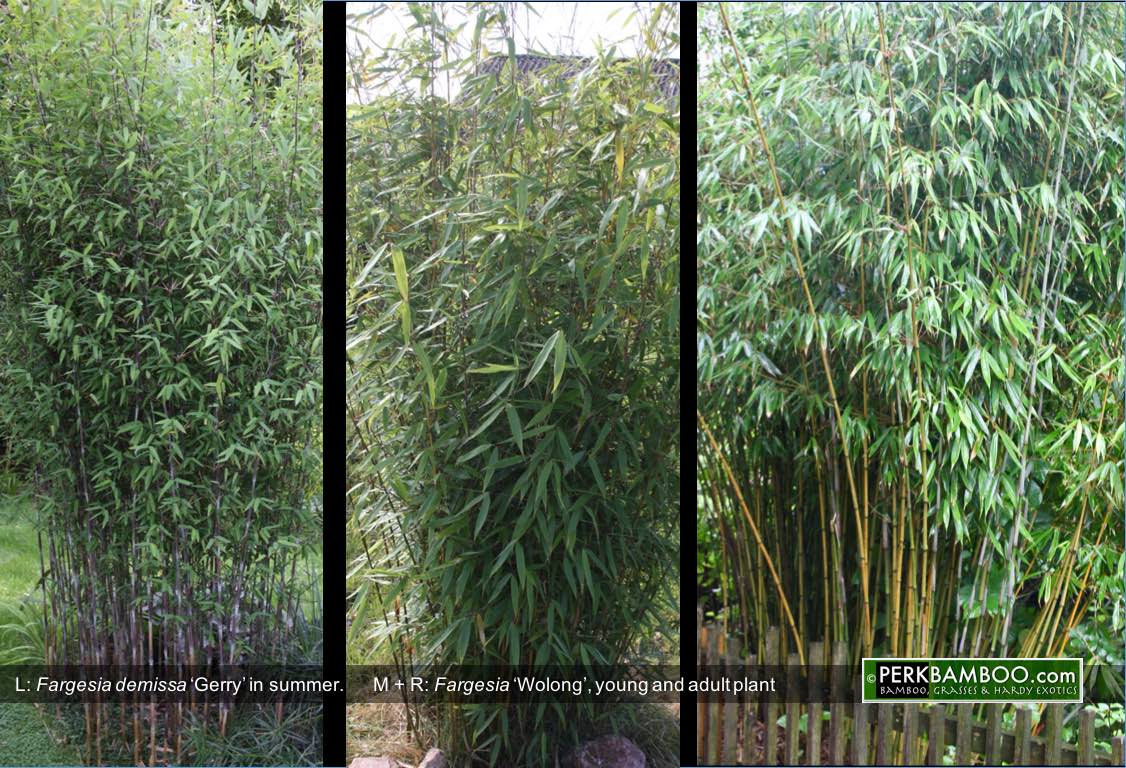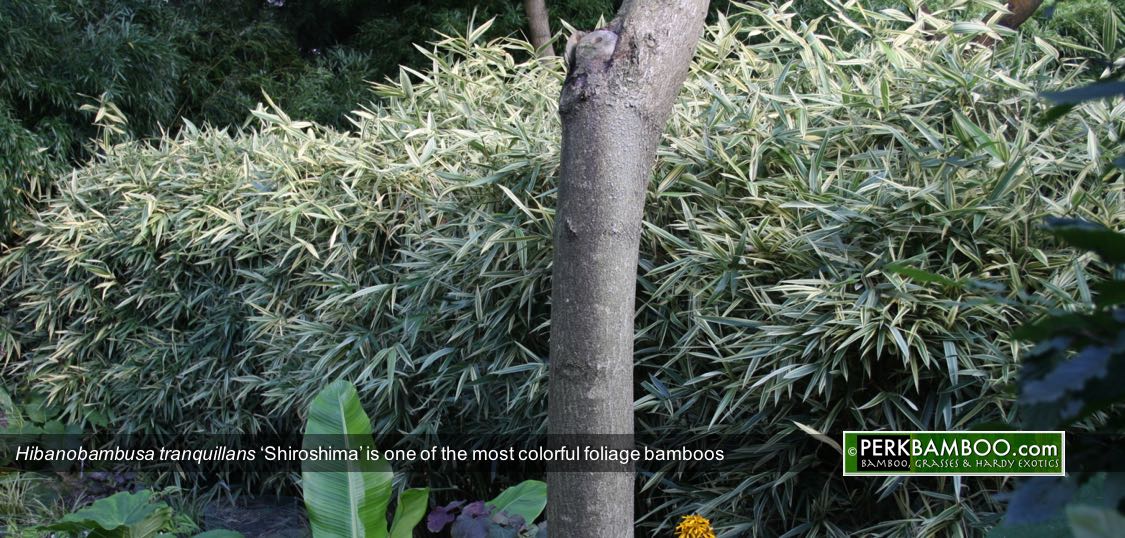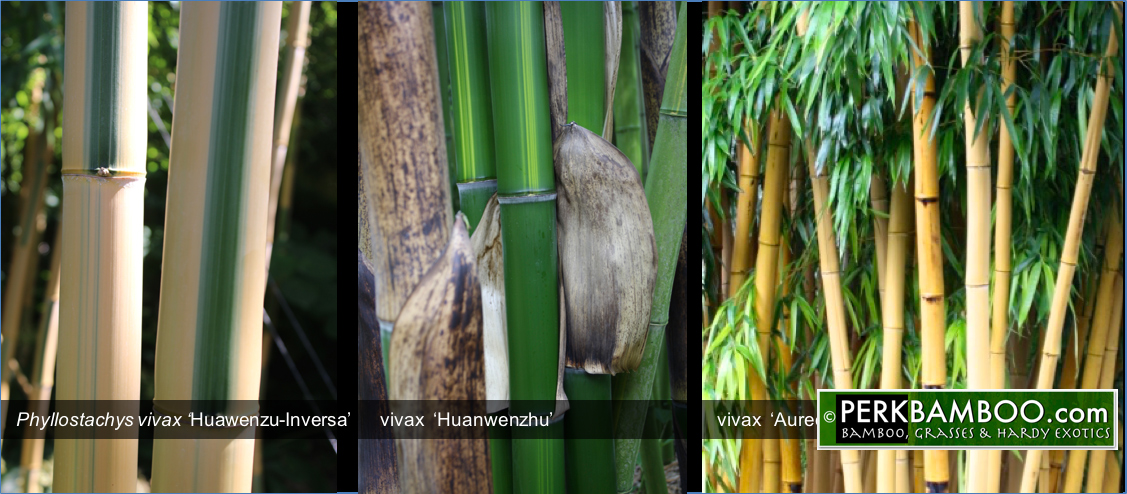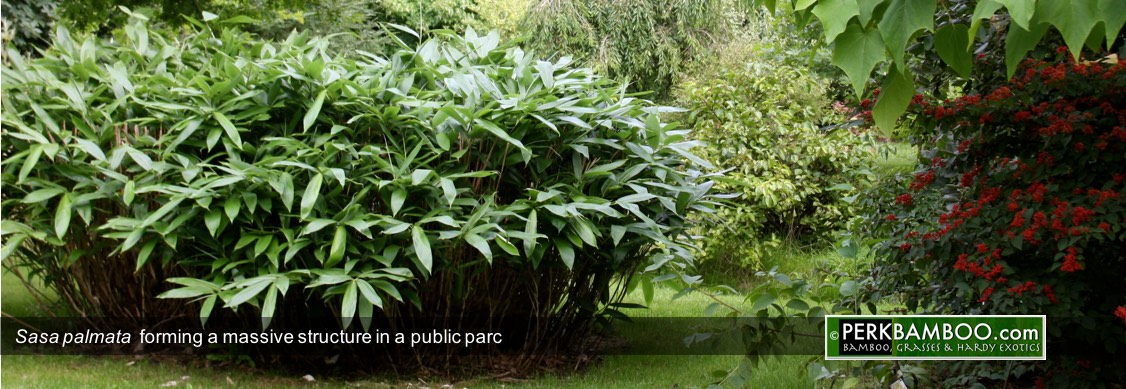BAMBOO SOLITAIRY
Several bamboos are outstanding solitary plants in a garden or park because of their decorative value. Think of the fountain shaped Fargesia’s on an open lawn or overhanging a pond. The different culm colors and forms of pruned Phyllostachys are strong vertical elements. Striking effects can be achieved with a massive clump Sasa palmata 'Nebulosa' in the lawn, the columnar shape of Semiarundinaria, the white striped culms of Fargesia robusta ‘Campbell' and the variegated leaf of Hibanobambusa tranquillans ‘Shiroshima’, just to name a few. Below I describe some of the most interesting species for solitary use in more detail.

CHIMONOBAMBUSA TUMIDINODA
Chimonobambusa tumidinodais a beautiful bamboo with remarkably thick knots. This rare bamboo, also called Qiongzhuea tumidissinoda grows 2 3 meters high. The Yi people in Sichuan, China protected this sacred bamboo with their lives to protect trade in canes. Yet in the late 80s a planthunter managed to import this plant in England, since than it has become available to bamboo collectors. It is growing on rhizomes, so plant it within bamboo root barrier. The culms are initially bright green and change color to olive green. Very nice as being pruned solitary. There are multiple clones in circulation. It is a more picky bamboo which grows best in "dappled shade" in an (light) acidic soil. In our garden we planted Chimonobambusa tumidissinoda 'Eddington Clone’ with very fine leaves. Slightly larger leaves has tumidissinoda ‘Intermedia'. The type with the largest leaf is tumidissinoda 'Macrophylla'. The ‘Eddington Clone’ is frequently available from a limited stock.

FARGESIA BAMBOOS
There are several fountain shaped Fargesia bamboos which are very suitable as solitary plants.
Fargesia apicirubens is growing into a vase shape of 2 to 3 m high. This species holds its medium to dark green leaves during winter. The culms become discolored on the sunny side to a dark hue. It is a relatively slow grower with good winter hardiness.
Fargesia denudata Lancester 1 has a beautiful arching habit with more lighter green small leaves.
Fargesia nitida hybrids grow into busy, dense plants with dark culms. Also the smaller Songpan types are of potential interest
Fargesia dracocephala ‘Rufa’, type 1 grows upto 2 m with a compact busy habitus. Type 2 grows much higher, upto 4+m. Fargesia demissa ‘Gerry’ is a quirky new bamboo with an open growth habitus, the beautiful upright culms have a silvery white frosting which later turns to purple. It shows its qualities best in a sunny place. 'Gerry' is fully hardy but half deciduous, making this plant has little leaf volume in winter. It grows upto 2 3 m. Limited stock.

Fargesia robusta 'Wolong' is currently one of our largest clumping bamboos. This plant has large leaves can grow over time to a height of 4 to 5 meters. 'Wolong' produces relatively early in spring new shoots and repeats this in autumn often with a smaller series of new culms. This big leaved form is more vulnerable to heavy frost compared to Fargesia robusta ‘Campbell’, but after frost damage, the recovery is good. In sheltered places like at our show garden, the mature plant has hardly suffered frost damage after severe frosts as in February 2012. At open, exposed locations however, frost damage was considerable, but recovery was good. A wonderful clumping bamboo as solitary or as broad hedge. There are several forms in circulation under the name ‘Wolong' (which might not even be Wolong); the type that we grow is more upright than other forms. ‘Wolong’ keeps its leafs under all weather conditions open (does not roll) and has relatively thick, shiny green culms with prominent knots.

The group of Tibetian Borinda species (Chris Stapelton) is also interesting for solitary use. Species within this group are still under observation, but the types Borinda (papyrifera) KR5287, KR7613 , KR6438 (Grex), KR5931 and KR6791 seem to be most promising. (KR = collection number by Keith Rushforth).
The South American species from the Andes Mountains are also interesting solitary bamboos for protected plant spots or mild areas, but not easy to propagate and are moderately hardy. Chusquea culeou, and Chusquea breviglumis (gigantea) have been planted out several times in our trail garden with varying succes.
Fargesia sp. Scabrida is originally imported from northern Sichuan China in 1997 by Jos van der Palen and Hans Prins, This bamboo is related to Fargesia robusta with regard to the early sprouting and very hairy shoots. The leaves are narrow and the culms fade in the sun to blue and purple in combination with the orange brown culm sheets and grow further apart. This beautiful bamboo has an open, upright growth and needs space as solitary. ‘Scabrida’ also does well in full sun and does not roll its leaves during frost or drought. Plants named Fargesia scabrida 'Asian Wonder' are propagated from tissue culture (in vitro). We deliberately do not grow tissue culture bamboos because of different growth properties. We only work with hand made divisions from the original mother plants so that we can be sure of its original properties and quality.
Hibanobambusa tranquillans ‘Shiroshima’ is a relatively large leaved bamboo with a striking leaf variegation. It grows up to 2 3 m with a dense canopy, it is moderately spreading. In winter the strong leaf variegation doesn’t fade as many other variegated species do. This species grows on rhizomes and is moderately spreading. It is recommended to plant it in a ring of rhizome barrier.

Bamboo species with striking culm colors are ideal to use as a solitary specimen. By thinning out culms, and cutting off the side branches, the focus is even more on the striking culms colors. A spotlight from the basis accentuates the forms even more in the dark. Kimmei forms have a color of the sulcus which is significantly different, often a yellow culm with green vertical lines give a special effect.

Very hardy species with remarkable culms can be found in the aureosulcata group.
Phyllostachys aureosulcata has a green stalk with egg yolk longitudinal stripe to turn the blade (sulcus). In addition, there are a number of interesting cultivars.
Phyllostachys aureosulcata 'Spectabilis' has a yellow culm with a green sulcus. New culms show redish coloration.
Phyllostachys aureosulcata ‘Aureocaulis' is completely yellow with lemon colored new culms and warm ocher yellow colored older stems. The sun side of new culms turn into orange or red.
Phyllostachys aureosulcata ‘Harbin Inversa' has very fine vertical lines over the yellow ribbed culms.
Phyllostachys aureosulcata ‘Argus’, a new variety with variable vertical lines, is perhaps the most striking cultivar but still very limited available.


Phyllostachys nigra has high decorative value because of its black culms. Because of its limited winter hardiness this species is only recommended for sheltered gardens.

PHYLLOSTACHYS VIVAX
Within the group of Phyllostachys vivax, a giant bamboo species, a similar set of color cultivars occurs. Vivax is able to grow up to 8 12m with culm diameters upto 8+ cm. Phyllostachys vivax 'Huanwenzhu' has a green culm with a yellow sulcus.
Phyllostachys vivax ‘Aureocaulis' is ocher yellow with sometimes variable green vertical stripes. Phyllostachys vivax 'Huanwenzhu Inversa' is a relatively new form with a yellow culm with variable vertical green lines, including a green sulcus, similar to Phyllostachys aureosulcata 'Argus', but with a thicker and higher culm. The vivax bamboo is one of the fastest growing giant bamboo species for colder climates. In our bamboo garden beautiful mature specimens can be found.

Sasa palmata forms a massive clump covered with large palmate leaves in a wave form. In contrary to many other species, this is not a transparant. Sasa palmata is able to create spatial mass in a landscaping design up to 2,5 / 3m in a lawn, at the edge of a forested area, in the middle of a lawn or alongside a pond.

Semiarundinaria viridis is interesting as a vertical solitary plant in modern, straight lined landscaping designs and architecture. Its straight, upright culms have short side branches with a bit bigger leaves compared to Phyllostachys. Its growth structure is compact, columnar, making it an excellent species as a stylistic landmark plant. We prefer to grow Semiarundinaria viridis above the more common Semiarundinaria fastuosa because of better hardiness.



